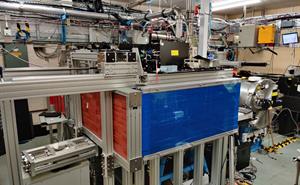Laser wakefield accelerators are 1000 times stronger than conventional machines, offering a compact alternative to conventional accelerators. A laser wakefield accelerator works by using a high intensity laser pulse to drive an accelerating cavity in a plasma, which can be used to accelerate electrons. These accelerators could be used, in everything from consumer electronics to cancer treatment. They are unique because they combine high-powered lasers with plasmas to generate a compact source of electron and x-ray beams.
With the number of laser wakefield accelerators experiments growing, it's only natural to try and optimize the machine's setup. Imperial College London led a study, published in Nature Communications, with a team of collaborators from the Central Laser Facility's (CLF's) Gemini Laser Facility, the York Plasma Institute, the University of Michigan (USA), the University of Oxford, and the Deutsches Elektronen-Synchrotron (DESY) (Germany).
Experimentally, the accelerator can be tuned by performing a multi-dimensional optimization of the laser parameter and plasma parameters, however, that's challenging even for a highly trained researcher. Instead, researchers aimed to automate the optimization of a 100 MeV-accelerator using a machine learning (ML) algorithm. The algorithm was simultaneously able to control up to 6 key laser and plasma parameters, fire the laser, analyse the results, and then change the parameters. The machine performed this operation several times and explored the parameter space in such a way to predict the best conditions for producing electron or X-ray beams, making it the first automated plasma accelerator set-up.
Additionally, researchers demonstrated that the set-up of the laser wakefield accelerator is flexible and can be tuned to optimize a specific property of the beams such as charge or energy. During the experiment it was seen that the algorithm allowed subtle tuning of the laser pulse shape which caused an 80% increase in electron beam charge with little change to the overall duration of the pulse.
 We are on the edge of the “fourth paradigm" of data-driven discovery and within that realm, this study highlights the possibility of exploiting ML techniques to produce a fully automated plasma accelerator, whilst synchronously uncovering never-before-seen insights into the fundamental physics of the machine.
We are on the edge of the “fourth paradigm" of data-driven discovery and within that realm, this study highlights the possibility of exploiting ML techniques to produce a fully automated plasma accelerator, whilst synchronously uncovering never-before-seen insights into the fundamental physics of the machine.
Dr Chris Thornton, UKRI-EPSRC Innovation Fellow and beamline scientist for the experiment said,"These impressive results have shown what can be done when AI is applied to new fields such as laser wakefield acceleration. This new method of optimisation could save many working hours of manual operation and make the technique more accessible, key to making laser wakefield accelerators more widespread."
